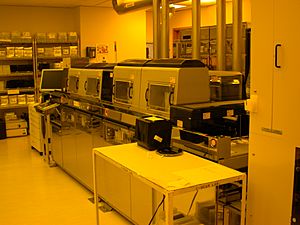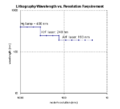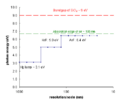Photolithography facts for kids
Photolithography is a super important process used to make the tiny parts inside computers and phones. Think of it like a special kind of photography that helps "print" really small designs onto materials. It combines ideas from photography (using light) and lithography (a printing method). This process is key to making integrated circuits, which are the "brains" of almost all electronic devices.
Contents
How Computer Chips Are Made
Photolithography is how we create integrated circuits, also known as computer chips. These chips are found in everything from your smartphone to your computer's central processing unit (CPU).
Step-by-Step Process
Making a computer chip involves a few cool steps:
- First, a thin, flat piece of material, usually silicon, is prepared. This is called a "wafer."
- The wafer is covered with a special liquid called a "photoresist." This liquid reacts to light.
- Next, a "photomask" is used. Imagine this as a stencil with the tiny design of the chip on it.
- A bright light is shone through the photomask onto the wafer. The light passes through the clear parts of the stencil and hits the photoresist.
- Where the light hits, the photoresist changes. It either becomes harder or softer, depending on the type of photoresist used.
- After the light step, the wafer is dipped into a special liquid, like a mild acid. This liquid washes away the parts of the photoresist that were not hardened (or were softened) by the light.
- What's left is the tiny pattern of the chip etched onto the wafer! This pattern can then be used to build the different parts of the chip.
Why This Process Is Important
This amazing process allows us to create millions or even billions of tiny parts on a single chip. For example, a memory chip, which stores information, has countless identical sections. Because photolithography can make these patterns so small and so precisely, it's possible to build powerful computers and devices that fit in your pocket.
Images for kids
See also
 In Spanish: Fotolitografía para niños
In Spanish: Fotolitografía para niños





